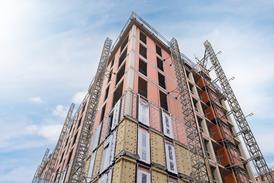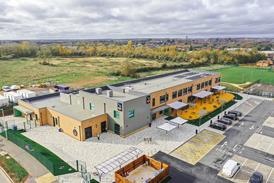Although recovery in the commercial market may be just around the corner, canny developers are already active generating good returns in refurbishment. Here Davis Langdon & Everest and Mott Green Wall look at the opportunities and constraints in bringing existing buildings bang up to date
Office refurbishment
Not every business needs a top-spec office with deep floorplates and full air-conditioning, but in this design-conscious world many occupiers are looking for space that communicates positive messages about their organisation and its culture, preferably in a good location and at a competitive rent.
Office refurbishment gives developers and occupiers the opportunity to optimise the value of a building without the investment risk and cost that is associated with full-scale redevelopment.
Sub-markets that favour refurbishment buildings include media and design companies, which do not have large workforces, but do value space with character, and place a premium on location rather than the absolute quality of the building. Office markets areas such as London’s Soho and Clerkenwell have all been partly driven by refurbishments aimed at non-corporate occupiers.
Overall, although refurbishment might not secure the highest possible land value, it does present a relatively quick and cost-effective method of improving property values, while retaining the high development density of an existing building that planners might not permit in a full redevelopment. In summary, the main advantages of a refurbishment project are:
- Speed to market – fast construction, minimised planning and party wall issues, together with opportunities to phase construction works if necessary to manage cash flow or work around existing tenants
- Retention of the advantages of the existing building – character, development density and massing, retention of car parking
- Cost – relatively low cost, with a proportionally high recovery of capital allowances. Developers can focus expenditure on value-adding features once the building fabric is sound
- Flexibility – opportunities to tailor the extent or the timing of the refurbishment to market conditions, reducing funding costs and maximising occupancy
- Sustainability – refurbishments use fewer resources and create less waste than new building projects, and contribute to sustainability by improving the performance of the existing building stock.
Defining the scope of refurbishment
The nature and the condition of a building, its location and potential position in the office market, economic conditions and the investment timescale of the developer will determine the extent of its possible refurbishment. Buildings with inherent long term value related to location, character, future planning constraints or listed building status might justify significant investment in refurbishment. Buildings with a short life and a limited potential to generate increased rental streams might, on the other hand, only justify a limited investment to attract short-term tenants ahead of disposal or comprehensive redevelopment.
- Minor refurbishment The main purpose of a minor refurbishment is to extend economic life by up to five years. Opportunities for payback are limited with the scope of work being confined to redecoration and repair works, together with minimal alterations to building services. The focus of the investment will be on common areas. Minor refurbishment is often carried out in an occupied building, with phased working and a decant plan being necessary.
- Medium refurbishment These projects aim to renew the existing fabric and services of a building to present day standards of performance. The investment timeframe is typically 15 years and, as a consequence, fittings, finishes and elements of building services will be replaced or upgraded, taking advantage of technological advances. Limited structural alterations, including the formation of new service risers and the creation of feature reception areas may also be involved, together with any works required to comply with statutory requirements for accessibility. These works can also be carried out in occupied buildings requiring additional temporary works, services diversions and out-of-hours operations.
- Major/total refurbishment Schemes which aim to secure, for the long term, the benefits of existing planning consents, or to exploit opportunities to increase useable floor areas are aimed at an investment horizon of at least 15 years. The refurbished building will need to meet modern expectations for specification and performance standards. All fittings, finishes and services will be replaced and it is highly likely that the roof and/or facade will be replaced or upgraded, together with extensive work to improve accessibility. Structural alterations may include the reorganisation of vertical circulation, the infilling of redundant light wells, creation of atriums, or the extension of perimeter floor slabs. Works will be carried out in a vacant building, and as a result, major refurbishments should deliver projects faster than new-build.
- Due to the wide range of options available to occupiers and the effects that building condition and constraints will have on the works, the range of costs for each grade of refurbishment are broader than would be expected for new build construction. Costs are set out in the table below.
- Building services – achieving modern performance standards
- Many buildings targeted for refurbishment were not designed for air-conditioning and may have facades that need to be upgraded to meet modern performance standards. On older buildings, the impact of narrow column centres and an irregular structural grid on distribution design may further complicate matters. The services engineer is likely to face constraints on floor to ceiling height and air distribution routes, with high perimeter loads associated with excess solar gain.
- The simplest cooling and ventilation systems, typically involving supply and extraction of centrally-treated air, have the advantage of keeping all chilled-water distribution on the roof, but depend on the ability to thread large air ducts through the building. If riser and floor void capacity is constrained, then minimum fresh-air systems using local sources of cooling will be specified.
- Progress has been made in miniaturising active systems such as fan coil units, reducing the overall requirement for ceiling voids. But static systems using chilled ceilings and beams are more easily incorporated into buildings with limited headroom, and are increasingly being adopted in the commercial market.
- Static cooling systems offer improved comfort conditions, reduced energy consumption and running costs, low noise and simple installation. However, capital costs are higher than for fan coil units and cooling capacity, particularly for chilled ceilings, is low.
- Chilled ceilings are the lowest cost option for static cooling but do not have sufficient capacity to deal with perimeter heat loads or high occupancy. Where the performance of the facade cannot be improved, chilled beams can used to increase output, but will require the ceiling void to increase in depth from 180mm to at least 350 mm. In situations with further constraints on headroom, active chilled beams can be installed as multi-service beams, incorporating lighting and communication installations in addition to heating, cooling and ventilation, dispensing with the need for a continuous ceiling void. Chilled beams need to be installed at regular centres for uniformity and divisibility and generally suit the regular floor plates often found in post-war buildings.
- Further constraints and building condition issues that need to be considered as part of refurbishments include:
- Implications on building operation if existing windows with opening lights are retained – particularly in passively cooled schemes where humidity control is an issue
- Identifying riser routes in previously naturally ventilated buildings
- Builders’ work implications of installing air and water distribution on the office floor.
A significant source of risk is the existing electrical supply capacity, which, on a naturally ventilated building may not be sufficient to cope with the additional loads associated with mechanical cooling and air handling. Due to limited capacity in the existing infrastructure, Supply Authorities often seek to limit the size of LV supply available from the street network. Having to install a new or upgraded substation, even on modestly sized projects, could significantly add to cost and programme.
The table of indicative costs below sets out the overall cost implication of the selection of ventilation and cooling options. As each option has implications for the costs of other services systems, the fit-out costs cover the typical scope of a services installation, excluding small power and communications. Requirements for raised floors and suspended ceilings also vary and are included.
Managing risk on refurbishment projects
The risk profile of office refurbishment projects can be high, because it means working in existing buildings with the constrained budgets and programmes required to deliver commercially viable schemes. Working in occupied buildings introduces further potential for delay and reduced productivity associated with, for example, the phasing of works.
Building condition is a primary source of risk. Structural load capacity can be a significant issue, with other sources of risk including asbestos, redundant services and a legacy of ad hoc repair, maintenance and alteration. Detailed site surveys, based on the opening-up of the structure are essential for designers and contractors and are ideally undertaken ahead of detailed design. However, this is often impractical, in terms of access to the building or the speed of the programme.
Further sources of unforeseen work relate to dimensional co-ordination, or the need to stabilise the existing fabric before new work can be completed. With many of these sources of disruption, it is difficult to foresee them in a partial building survey or a risk management plan, so it is important to have contracts, contingencies and change management mechanisms in place to deal with unexpected events.
Contract and contractor selection
The duration of refurbishment schemes is often short and uncertainty associated with the condition of the building and scope of work is high. However, lump sum procurement, based on sequential design and construction, can often deliver the best overall results. To do so, the design needs to be complete before construction starts and variations, other than those related to building condition, need to be kept to a minimum. Fast-track approaches such as Construction Management, or two-stage tendering can themselves be a significant source of risk if the production of design information cannot keep pace with progress on site.
Specialist expertise and a good track record are key criteria in selecting contractors and subcontractors. Depending upon the scope of work and whether the building is occupied, areas of experience to consider include:
- Calibre of management and quality of work
- Capability to manage temporary works, structural alterations and complex building services installations
- Management of work in occupied buildings, including tenant and neighbour liaison and health and safety management
- Management of phasing, such as restricted working conditions, to control noise and other disruption.
In order to meet tight programmes, it may be beneficial either to let separate enabling works contracts for site investigation and demolition works, or to appoint a contractor on a two-stage basis. This also secures contractor input into programming and procurement of long lead-in items at an early stage. Specialist subcontractors should then ideally be appointed on the basis of joint, open book, competitive tenders before a lump sum contract is agreed – preferably ahead of the commencement of the main scope of works on site.
Cost model
The cost model, starting overleaf, features the upgrade of an Edwardian city-centre office building with ground and basement retail. The scope of works of this major refurbishment include the complete reconstruction of the core and the creation of a new atrium in the space created by infilling a light well, together with the improvements to the facade, reconstruction of a mansard roof and the installation of a displacement ventilation system in fully refitted office space finished to category A. The overall gross internal floor area of the completed scheme is 4400 m2, an increase of 700 m2, yielding a net office area of 2430 m2.
Costs are current in second quarter 2004, based on a two-stage tender and a lump sum contract, for a project located in central London. Demolitions, preliminaries and contingencies are included in the costs, but external works, tenant fit-out, professional fees and VAT are excluded. Costs can be adjusted for location using the regional factors in the table shown.
Property taxation
Capital allowances
Tax allowances available as an incentive for investment in commercial buildings are a significant component of the refurbishment development equation, with potentially 50 to 70% qualifying for capital allowances as expenditure on plant and machinery. The value of this expenditure is written down at 25% per year on a reducing balance basis, so that 94% of the expenditure will have been allowed as a tax deduction against rental income within 10 years. The value of the claim should also include for elements of preliminaries and professional fees.
In existing buildings, the value of ‘incidental alteration work’ can also be included in the claim for allowances. This could include forming new lift shafts and risers, and more conventional builder’s work. Allowances are also given on works required to comply with the 1971 Fire Precautions Act.
Land remediation
The cost of removing asbestos and other harmful materials from a building may qualify for tax relief. This allowance, worth 150% of the amount of qualifying expenditure, can be set against all taxable income in the first year.
Revenue expenditure
In addition to capital allowances the client can usually deduct elements of refurbishment work as revenue expenditure. When this is possible the whole cost is allowed for tax purposes in the year that it is incurred. Only repair and maintenance work and like-for-like replacement of items such as suspended ceilings or sanitary fittings will qualify, although using modern substitute materials and replacing single-glazed windows with double-glazed windows may be allowed. A building must have been (or be capable of being) in beneficial use and generating income prior to the work being carried out.
Maximising the value of claims
Claims on refurbishment projects, involving analysis of builder’s work and so on, are potentially complex. Successful claims rely heavily on evidence derived from project documentation that isolates the costs of qualifying work and associated builder’s work. Early consideration of both design and documentation can help to recover additional tax allowance benefits for the client.
























No comments yet